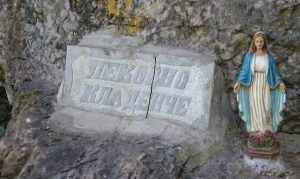

Medieval church “St. Nicholas” is located at the southern end of Dolna Verenitsa. There is no exact information about the time of construction of the temple, but approximately dates back to the XVI century. In order to get its current form, the building has undergone several construction stages. The original building dating to the probable end of the sixteenth early seventeenth through nineteenth west wall was demolished and added a rectangular room with the volume of the nave has doubled. In the twentieth west narthex was added to the flimsy walls, which belongs to the third stage of the reconstruction of the church. In the second half of XX, after the plaster of the oldest part of the temple were discovered medieval frescoes, the church was declared a cultural monument of national importance.
Architecturally the ancient church building is a small ship, with wide semicircular apse, on the side walls of the ship has two high niches (on the south wall there is a narrow window). Inside the temple stand out some interesting features – spiked profile of the apse and some niches located on the north wall and south. According to experts these gothic elements penetrate the local Orthodox architecture through Catholic ancient churches from Chiprovci and Kopilovtsi. The church nave is buried three feet below the level of court. It is vaulted with a massive semi-cylindrical dome and the narthex is covered by a wooden structure. The church has two entrances – the main one in the west and a second one on the north wall. The walls from the oldest part of the temple were completely covered with frescoes, and most of them have reached us in good condition.
Donors from ancient times are in the paintings and this is reflected by the portrait of the donor who has an inscription placed in the western niche on the north wall. The iconographic scheme is in line with the Orthodox canon. In the altar are scenes with an interesting approach and monumental iconographic images of saints of various creeds. In the above apse is painted “Maria Shirshaya” and in the images below are painted the six Fathers of the Church. In the canonical niche is painted Christ in His grave, in the southern alcove of the apse is described the St. Book. On the south wall, at full height, is painted St. Cyril of Alexandria. In the scenes within the nave are included decorative figures, adapted to the internal architecture particularities. On the first strip over the base, among the saints, are represented, in full height, the donors, and these niches on the south wall are very pale. Above, the lower belt has a frieze with medallion images of the saints. In the spring vault, above the frieze, are placed two registers. At the bottom are included scenes from the life of the the church patron – St. Nicholas and the first known evangelical scenes. The zenith of the spring is occupied by medallions: the Ascension of Christ (above the altar space), Christ Pantocrator Christ Emanuel. Throughout the entire vault are three compositions with images of Christ divided on both sides with a frieze of small medallions with saints. The newer western part of the ship is partially written, in the 70s of the nineteenth century. As it is distinguished, the paintings are far from the medieval ones. Across the eastern wall of the narthex is the complex composition “Last Judgement”, probably written in the nineteenth century. It is assumed that this work is the work of the painters from Tryavna. In the niche, as a protector, above the door, is represented St. Nicholas, and on other two niches were painted the Virgin Mary and Christ. The iconostasis is worked in the first half of the nineteenth century. By an unknown master, the vegetable ornaments please the eye with beautiful shapes and warmth of the wood. Interesting are the royal doors with small medallions, surrounded by wood carvings and more, probably made by the end of the eighteenth century. The icon Sv Georgi painted by Father Puncho – by schematic wetting, but with the desire to have an impact. Among other icons painted by Puncho is that of St. Demetrius, who, according to art critic prof. Asen Vasilev does not kill Tsar Kaloyan. Under the icon is a pictogram dated 1810, similar to the name of the person killed by saint Demetrius, which was, also seen by the art critic, in the “Sv. Marina” church in 1869, in Rendina, Thessaloniki. And there the inscription of the icon was written in Slavic (not Greek). In the cemetery, on the east and south of the temple, are many interesting stone crosses that represent veritable masterpieces of applied art in Bulgaria. Currently, the ancient church of “St. Nicholas” from Lower Verenitsa was externally renovated just a few years ago, being in poor condition. What remains to be done is the restoration of medieval painting, which was damaged when the roof got water infiltrations.


